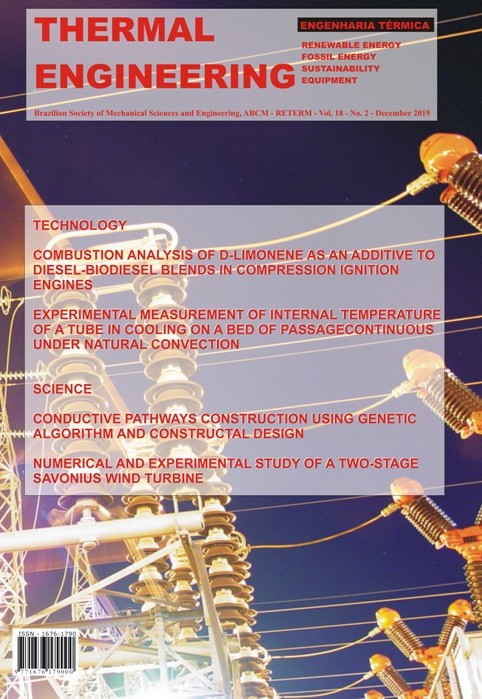THERMAL PERFORMANCE AND FLAME TEMPERATURES ON LPG RADIAL BURNERS IN DOMESTIC COOKERS
DOI:
https://doi.org/10.5380/reterm.v18i2.70787Keywords:
energy efficiency, energy labels, combustion, premixed flamesAbstract
The objective is to investigate radial burners through experimental tests, looking for its thermal performance behavior. Gas burners in domestic cookers operate on LPG, typically with two different geometries and five thermal power conditions. Usually, those thermal equipment lacks information on its whole operating conditions range for higher energy conversion efficiency and lower fuel consumption; it is not pointed out by the manufacturer or by energy efficiency labeling, what could result in a recommendation for widely effective performance. Appropriate instrumentation was used to carry out the measurements and methodology used as a guideline regulations from INMETRO/CONPET, ABNT - Brazilian Technical Standards Normative, and ANP - National Agency of Petroleum, Natural Gas and Biofuels. Experimental measurements and uncertainties are for the following parameters: fuel mass consumption (kg.s-1), test time elapsed (s), temperature (°C), water mass (kg) and flame temperature by K-type thermocouples (quantitative) and a thermal camera (qualitative). Main conclusions are: a) Operating domestic cookers with handle position selector on middle position (TP3) provides almost the same temperature rise as maximum fuel consumption (TP5), i.e., ΔT in the water container; b) Heat is better transferred (Qgas → Qwater) with the handle position selector fully opened (TP5@B1) and just before fully opening (TP4@B2); c) A non-linear behavior occurs for ηThermal, when moving forward the handle position selector; maximum efficiency occurs at fully open (TP5@B2) and middle opening (TP3@B1); d) Higher values for TPexperimental occurs for B2, in comparison to B1, in whole operational condition ranges; differences are mainly due to geometric parameters (ARB2/ARB1~0.82). In general, B2 has a better geometric design; e) Uncertainty analysis indicate values lower than ±3%, proving to be a suitable methodology for the experimental results in this work; f) Flame temperatures are entirely consistent with both, ηThermal and heat energy delivered, reaching higher temperature values at TP4 for both burners; 751.5°C (B1) and 830.7°C (B2).
Downloads
Published
How to Cite
Issue
Section
License
Direitos Autorais para artigos publicados nesta revista são do autor, com direitos de primeira publicação para a revista. Em virtude da aparecerem nesta revista de acesso público, os artigos são de uso gratuito, com atribuições próprias, em aplicações educacionais e não-comerciais.



